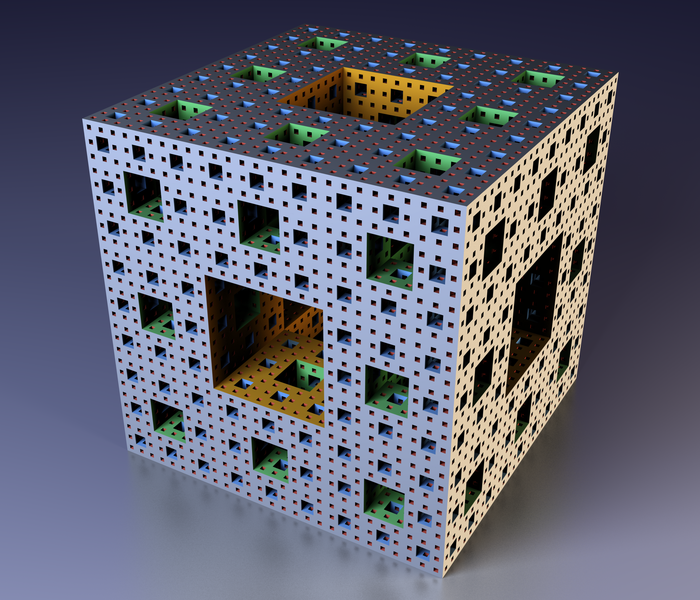Take a cube. Chop it into 3×3×3 = 27 small cubes. Poke holes through it, removing 7 of these small cubes. Repeat this process for each remaining small cube. Do this forever! The result is the Menger sponge.
What’s the volume of the Menger sponge? At each stage we remove 7/27 of the volume, so only 20/27 of the volume is left. As we repeat this forever, the volume drops to zero. So, the final volume is zero!
What’s the surface area of the Menger sponge? That’s a bit harder to work out, but it’s infinite!
What’s the dimension of the Menger sponge? That depends on what you mean by ‘dimension’.
You can compute the Minkowski dimension of a metric space by covering it with balls of radius 1/n, counting the minimum number of balls you need, and seeing how this grows as n→∞. If the growth rate is of order nd, the space has Minkowski dimension d.
For a 3-dimensional cube, the number of balls needs to grow as some number times n3. So, we say a cube has Hausdorff dimension 3. Similarly, a smooth curve has Minkowski dimension 1. But the Menger sponge has Minkowski dimension about
2.726833…
This number is not an integer. So, the Menger sponge is an example of a fractal.
What is this number? It’s
ln20ln3
The reason is that at each stage of constructing the Menger sponge we subdivide each existing cube into 27 smaller cubes and then remove 7, leaving 20. So, at the nth stage of the construction we have covered the Menger spong with 20n cubes having edges of length 1/3n.
There are also other concepts of dimension. The Lebesgue covering dimension of a topological space X is the least natural number n such that every finite open cover of X admits a refinement to a finite open cover in which no point of X is included in more than n+1 sets. For example, a smooth curve embedded in Rn has Lebesgue covering dimension 1.
The Lebesgue covering dimension of the Menger sponge is also 1. Moreover, Menger showed, back in 1926, that any compact metric space of Lebesgue covering dimension 1 is homeomorphic to a subset of the Menger sponge!
The image above was created by Niabot and licensed under the Creative Commons Attribution 3.0 Unported license. It is available on Wikimedia Commons.
Visual Insight is a place to share striking images that help explain advanced topics in mathematics. I’m always looking for truly beautiful images, so if you know about one, please drop a comment here and let me know!


